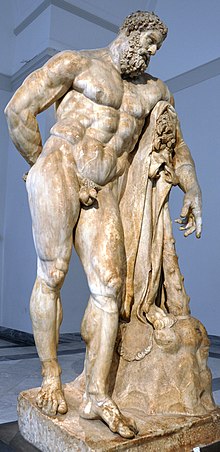Educational research into cultural protection of the Andean universal creations in a global context of archaeology and anthropology of architecture
Sunday, September 5, 2021
Was Sacsayhuaman a sacrificial altar of three sacred fires known as Agnitraya in the Vedic texts written in Sanskrit?
Friday, June 18, 2021
New book by prof. Janusz Z. Woloszyn titled Enemy - Stranger - Neighbour: The Image of the Other in Moche Culture was just published by Archaeopress Pre-Columbian Archeology
https://www.academia.edu/49072810/Enemy_Stranger_Neighbour_The_Image_of_the_Other_in_Moche_Culture?fbclid=IwAR0F9l7iy502UBe0VIRGcZJipqkMlaaJLlctuhvH0ZsaFxLNHIkjCslVvEc
Thursday, June 10, 2021
History of Heracles, the first South American and his Twelve Labors in the world

Farnese Heracles, Roman marble statue on the basis of an original by Lysippos 216 CE source: wikipedia
Heracles is best known for his 12 labors which represent his work of repayment for the murder in Thebes where Heracles married King Creon’s daughter, Megara, and in fit of madness (caused by vengeful Hera) he killed his children and wife.
The Oracle of Delphi, where he looked for guidance, manipulated by Hera, directed Heracles to serve King Eurystheus for ten years and perform any task his cousin required of him. Eurystheus gave Heracles ten labors each to be accomplished every year, but Heracles was cheated by Eurystheus who added two labors extra as follows:
1. Slay the Nemean Lion (S. America: Chile) 2. Slay the nine-headed Lernaean Hydra (Asia: Japan). 3. Capture the Golden Hind of Artemis (Europa: Poland) 4. Capture the Erymanthian Boar (Europa: Spain) 5. Clean the Augean stables in a single day (Africa: Marocco) 6. Slay the Stymphalian Birds (Africa: Mauretania) 7. Capture the Cretan Bull (Africa: bottom of the Atlantic Ocean in the international waters section of the Ocean) 8. Steal the Mares of Diomedes (S. America & Antarctica: details will follow) 9. Obtain the girdle of Hippolyta, Queen of the Amazons (S. America: Brasil) 10. Obtain the cattle of the monster Geryon (S. America: Chile and Argentina) 11. Steal the apples of the Hesperides (S. America: Chile and Argentina) 12. Capture and bring back Cerberus (Oceania: Hawaii, state of the USA)
Bibliografia:https://Hellenism.net Accessed 8 June 2021
https://en.wikipedia.org/wiki/Heracles
https://en.wikipedia.org/wiki/Hercules
https://en.wikipedia.org/wiki/Ceryneian_Hind
https://en.wikipedia.org/wiki/Greek_mythology
Monday, May 10, 2021
Colossal geoglyph in form of a Neanderthal mother with her baby could be seen from space only near London, Great Britain
Sunday, May 9, 2021
Based on Chakana, the sriyantra´s geoglyph and a symbol of a 600 kms diameter could be seen from space near Cordoba, Argentina
 |
|
author: C.H.Dabrowski source: @IVarsovienne via Google Earth |
In the Shri Vidya school of Hindu tantra, the Sri Yantra (Sanskrit "sacred instrument") is a diagram formed by nine interlocking triangles that surround and radiate out from the central point.
source: www.sriyantraresearch.com
It represents the goddess in her form of Shri Lalita or Tripura Sundari, "the beauty of the three worlds (Heaven, Earth, Hell)". The worship of the Sri Chakra is central to the Shri Vidya system of Hindu worship and is probably the most famous visual image in all of Hindu Tantric tradition. Its literature and practice is perhaps more systematic than that of any other Shakta sect (4). Four isosceles triangles with the apices upwards, representing Shiva (masculine energy) and five isosceles triangles with the apices downward, symbolizing Shakti (feminine energy) are balanced. Its design composed of nine triangles is also known as the Navayoni Chakra. (5)
source:www.sriyantraresearch.com
to see more details see the theme @IVarsovienne blog or @IVarsovienne.edu FB
Notes:
1) https://en.wikipedia.org/wiki/Shri_Yantra Accessed 31 May 2021.
2) Britannica, The Editors of Encyclopaedia. "Yantra". Encyclopedia Britannica, 26 Nov. 2003, https://www.britannica.com/topic/yantra. Accessed 6 June 2021.
3) https://www.wisdomlib.org/definition/shri-yantra Accessed 31 May 2021.
4) https://en.wikipedia.org/wiki/Shri_Yantra Accessed 31 May 2021.
5) https://www.wisdomlib.org/definition/shri-yantra Accessed 31 May 2021. 6) https://www.wisdomlib.org/definition/shrividya Accessed 31 May 2021.
Friday, April 30, 2021
Chakana is the Andean cultures´s symbol based on the Sriyantra

Sunday, April 11, 2021
Lake Titicaca Hydraulic Civilization (43,000 - 12,900 BP) introduction
Results from the Jebel Irhoud site dating (a pre-modern phase in H.Sapiens evolution re: C.Stringer & J. Galway 2017) are confirming our theory that approx. 40,000 yrs ago in the vicinity of the the Lake Titicaca had begun a process on a large scale, during which concentrated and multilevel human activities took place, resulting in the creation of the Lake Titicaca Hydraulic Civilization (LTHC).
This process lasted until approx. 12,900 BP which corresponds to the Younger Dryas event, and it was then when catastrophic floods had changed drastically human conditions and a pattern of human existence in South and North America.
Initial phase was related to the extensive mining activities which were carried on for several thousands of years on a gigantic scale, and of which the final purpose we do not understand at this point. With depletion of important metallic minerals, the Mining Phase (approx. 40,000-21,000 BP) wained and was followed by the second Limited Phase (21,000-15,000 BP), during which the abandoned mines and degraded sites were slowly being adapted for the agricultural use. Corresponding climatic change forced new patters of behavior in the dryer and less friendly conditions, resulting the transition to the third Agricultural phase (17,000 - 12,900 BP), more known and important for our understanding of the global history , during which local population multiplied and created an extensive system of andenes and during which important ceremonial centers in Pucara and Tiwanaku were built. An extensive earthwork was carried out leading to create remote large water reservoirs (eg. Acmanuncocha, Laguna Sumbila, etc.) connected with surface canals, and alternatively with dugout ´rivers´ and perhaps complemented by ´dugout and cover´ underground puquis; unusually large coastal works re-shaped the Lake Arapa; evidence of aqueducts did not surfaced at this point, but we are not excluding their existence. This phase has been treated in more detail by other researchers.
see: Karl August Wittfogel (1896–1988), in his book Oriental Despotism: A Comparative Study of Total Power (1957)











